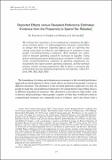Reported Effects versus Revealed-Preference Estimates: Evidence from the Propensity to Spend Tax Rebates
Author(s)
Parker, Jonathan A; Souleles, Nicholas S
DownloadPublished version (583.2Kb)
Publisher Policy
Publisher Policy
Article is made available in accordance with the publisher's policy and may be subject to US copyright law. Please refer to the publisher's site for terms of use.
Terms of use
Metadata
Show full item recordAbstract
<jats:p> We evaluate the consistency of two methods for estimating the effect of an economic policy: (i) asking people how the policy caused them to change their behavior (reported effects) and (ii) inferring this change using data on behavior and differences in treatment across people (revealed-preference estimates). Both methods are widely used to measure spending caused by increases in liquidity. Using federal stimulus payments disbursed quasi-randomly in 2008, we find larger revealed-preference estimates of spending propensities for households who report greater spending responses, and the methods produce similar average propensities. But evidence is mixed on the relationship between spending propensities and liquidity. (JEL C83, D14, D91, E62, H24, H31) </jats:p>
Date issued
2019Department
Sloan School of ManagementJournal
American Economic Review: Insights
Publisher
American Economic Association
Citation
Parker, Jonathan A and Souleles, Nicholas S. 2019. "Reported Effects versus Revealed-Preference Estimates: Evidence from the Propensity to Spend Tax Rebates." American Economic Review: Insights, 1 (3).
Version: Final published version